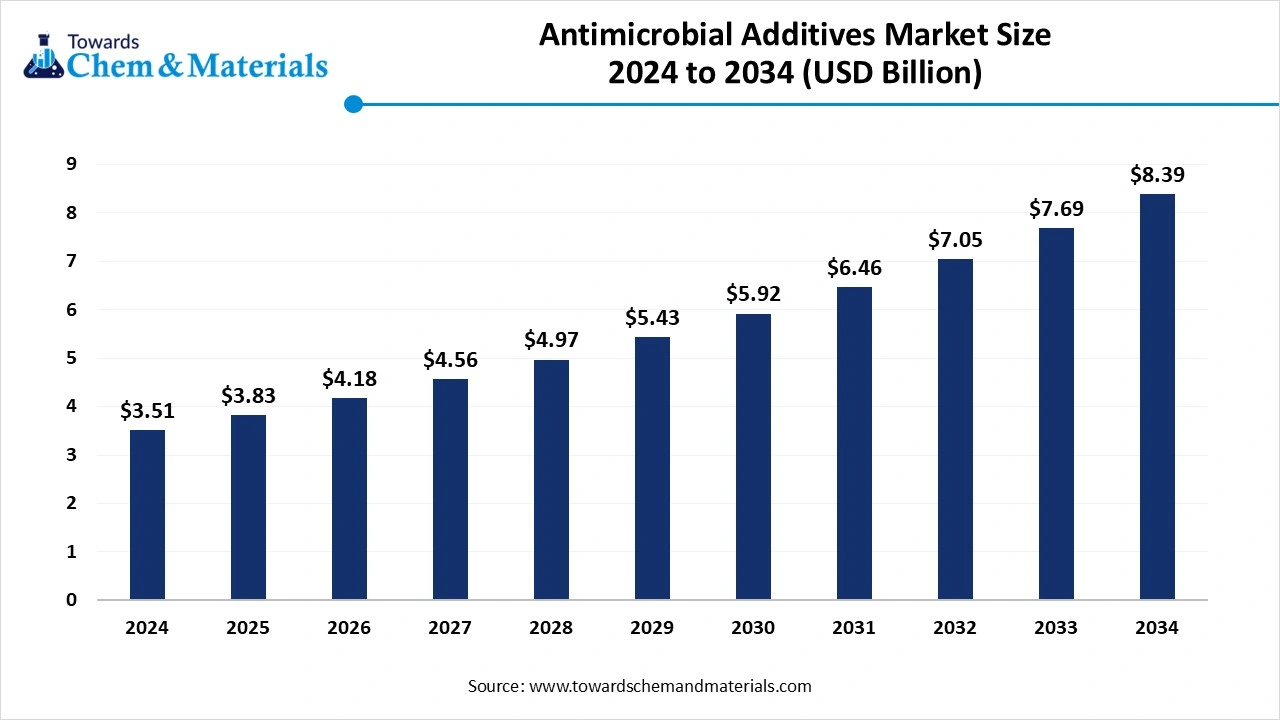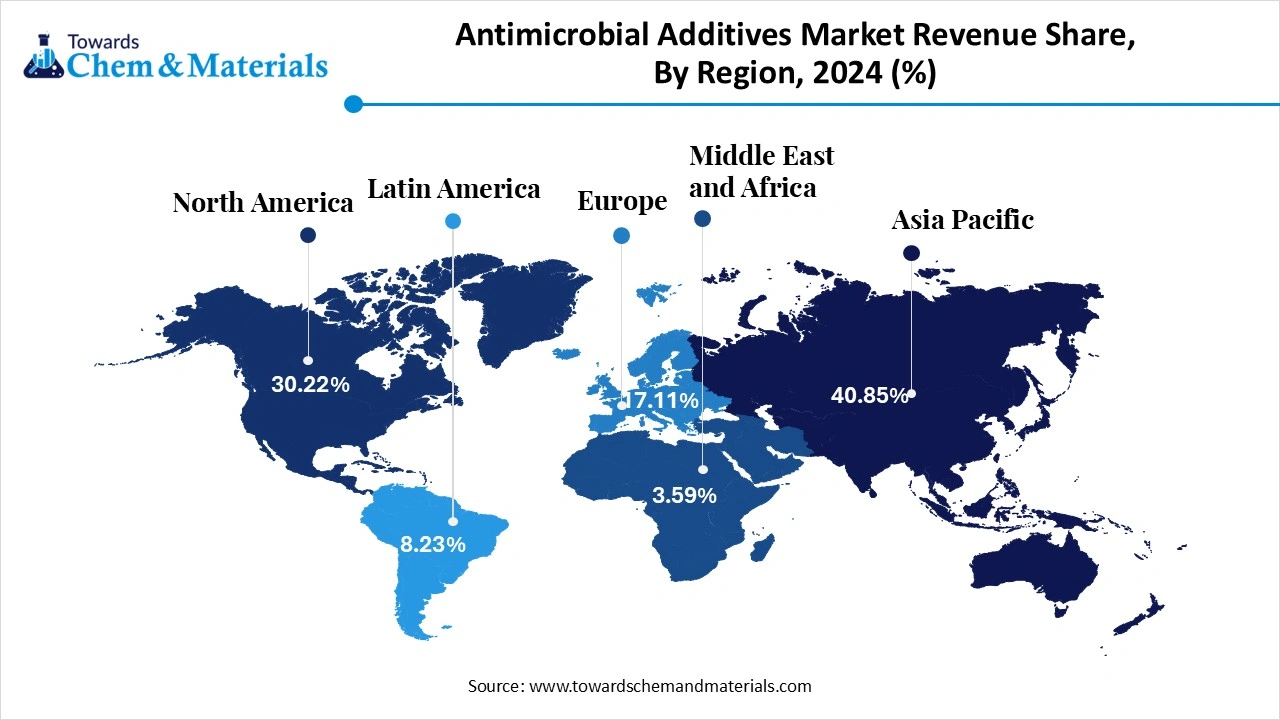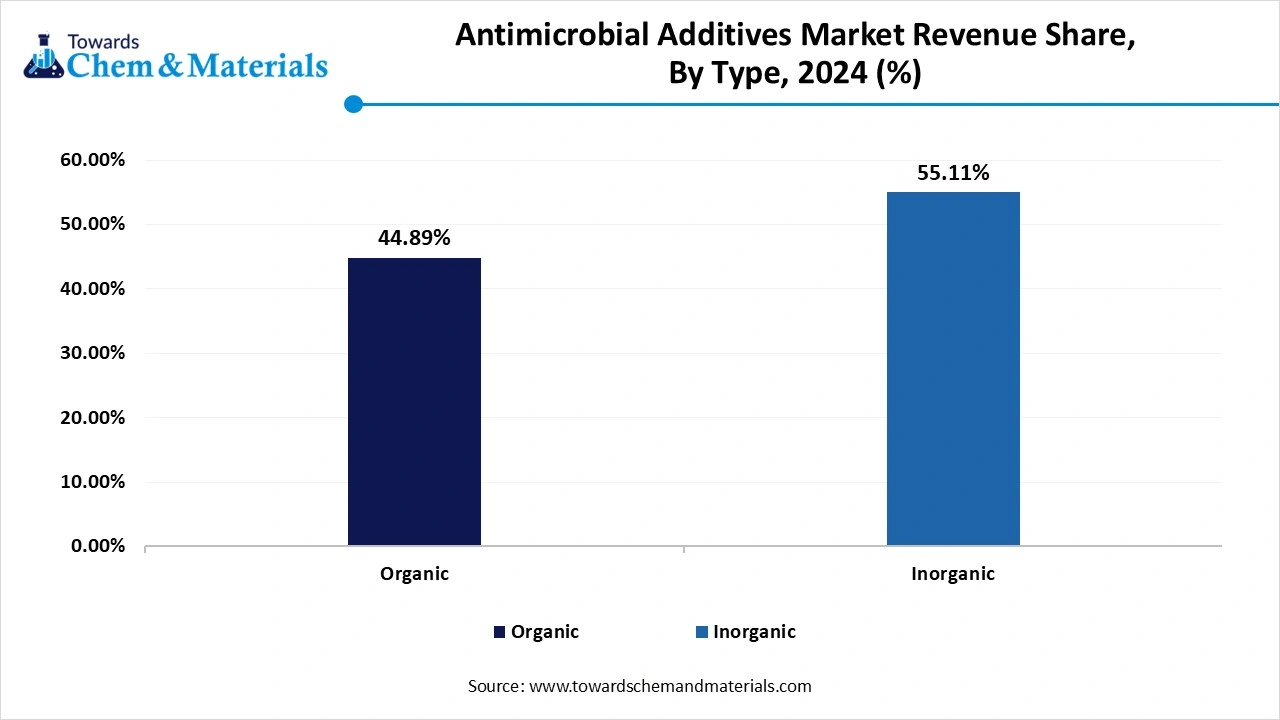April 2025
The antimicrobial additives market size accounted for USD 3.51 billion in 2024 and is predicted to increase from USD 3.83 billion in 2025 to approximately USD 8.39 billion by 2034, expanding at a CAGR of 9.11% from 2025 to 2034. The increasing demand for sustainable, eco-friendly, and clean quality additives for preventing the products from contamination and any microbial growth drives the growth of the market.

Manufacturers add antimicrobial agents to products and materials to actively stop the growth and spread of microorganisms like bacteria, viruses, fungi, and algae. These additives keep surfaces and materials clean and hygienic by preventing microbial contamination. Industries can integrate them into plastics, textiles, paints, and coatings without greatly changing the materials’ physical properties. By reducing the presence of harmful microbes, antimicrobial additives help create a healthier environment and support public health. In food packaging, they prevent spoilage and the growth of pathogens, effectively extending the shelf life of food products.
The increasing hygiene awareness, growing demand in healthcare, rising food safety concerns, increase in construction and infrastructural development, and technological advancement in the market drive the growth of the market. The increasing awareness about food safety and the need for microbial control in various industrial sectors helps in the growth and expansion of the market.
Government policies and health regulations are shifting the industries to use microbe-resistant materials, which also drives the growth of the antimicrobial additives market.
| Report Attributes | Details |
| Market Size in 2024 | USD 3.83 Billion |
| Expected Size in 2034 | USD 8.39 Billion |
| Growth Rate | CAGR of 9.11% from 2025 to 2034 |
| Base Year of Estimation | 2024 |
| Forecast Period | 2025-2034 |
| High Impact Region | Asia Pacific |
| Segment Covered | By Type, By Application, By End Use, By Region |
| Key Companies Profiled | NanoBioMatters Industries S.L,BASF SE,RTP Company,Milliken Chemical,BioCote Limited,Microban International,Clariant AG,PolyOne Corporation,Momentive Performance Materials Inc.,Life Materials Technologies Limited,SteriTouch Limited,Sanitized AG,Dow Inc.,LyondellBasell Industries Holdings B.V.,Plastics Color Corporation,Lonza |
The rising demand for sustainable and bio-based antimicrobial additives is driven by growing environmental concerns and stricter regulations on synthetic chemicals, creating an opportunity for the market to expand in various sectors. Consumers and industries are looking for eco-friendly alternatives that are biodegradable, non-toxic, and which are derived from natural sources such as plant extracts or essential oils. These bio-based additives offer antimicrobial protection without creating pollution or antimicrobial resistance.
They are especially used in applications like food packaging, personal care, and healthcare, where safety and sustainability are critical. This shift encourages the manufacturers to invest in green innovation, which creates new market opportunities and aligns with trends toward sustainability, which drives the growth of the antimicrobial additives market.
Environmental and health concerns are a significant challenge in the antimicrobial additives market. Excessive use of antimicrobial additives, especially metal-based types like silver or copper, contributes to environmental toxicity, affecting aquatic and soil ecosystems. Additionally, the overuse of antimicrobial agents leads to antimicrobial resistance, resulting in serious public health risks. Because of this, regulatory bodies impose stricter controls on the usage and disposal of the additives.
These concerns drive demand for more eco-friendly, biodegradable alternatives, but development and approval processes are costly and time-consuming, which slows down the market growth despite the increasing need for hygienic and antimicrobial solutions across various industries.

Asia Pacific dominated the antimicrobial additive market in 2024. The growth is seen due to rapid industrialization, a growing population, and increasing consumer awareness about hygiene and safety. The region's strong manufacturing sector fuels the demand for antimicrobial additives in various industries, including healthcare, construction, food packaging, and textiles. Urbanization and the rise of middle-class consumers in the region have increased the need and demand for better hygiene products.
The growing healthcare sector, with an increasing number of medical facilities and surgeries, also drives demand for antimicrobial solutions in medical devices and infrastructure. The new and advanced research in the region drives the antimicrobial additives market to grow.
China is the largest economy in the Asia-Pacific and a key player in the market. The country witness’s rapid growth in industries like manufacturing, healthcare, construction, and consumer goods, these sectors have high demand for antimicrobial additives, which help in the growth.
China's increasing population and increasing healthcare infrastructure have led to awareness of hygiene, prompting a higher demand for antimicrobial solutions in medical equipment, textiles, and packaging. Additionally, government initiatives focusing on public health, urbanization, and eco-friendly products provide wide opportunities for the expansion of the antimicrobial additives market in China.
North American is anticipated to grow in the antimicrobial additives market in the forecasted period. The growth of the market is primarily driven by the high demand for healthcare-related products, advanced manufacturing capabilities, and strong consumer awareness. The growth in the market is seen due to its well-established healthcare infrastructure, technological innovations, and regulatory frameworks that focus on product safety and efficacy. The region is also witnessing increasing applications of antimicrobial additives in consumer goods, packaging, construction materials, and automotive industries.
Additionally, the rising concerns for hospital-acquired infections and the increasing need for hygiene in everyday products help the market grow. North America's regulatory bodies, such as the FDA and EPA, have strict safety standards for the environment and use of eco-friendly and sustainable products, which ensures the growth of the market in the region.
The United States is the largest market for antimicrobial additives in North America. The country’s advanced healthcare system and growing concerns for hygiene and infection control drive the demand for antimicrobial additives in medical devices, healthcare facilities, and consumer products, which helps in the expansion of the market. The large food and beverage industry in the country demands antimicrobial additives for packaging to ensure product safety and extend shelf life. The stringent regulations from the regulatory bodies led to the adoption of safer and more effective antimicrobial solutions, boosting market growth. These factors and the application of the product drive the growth of the market in the country.
Europe seen a significant growth in the antimicrobial additives market over a period. The growth is driven by stringent regulatory policies and strong demand for high-quality, hygienic products across various industries. The region also has advanced healthcare systems, high consumer awareness, and a well-established manufacturing sector, which contribute to the adoption of antimicrobial additives. The increasing demand for antimicrobial solutions in healthcare, food packaging, construction, and textiles industries also results in the growth of the market. Additionally, an increasing focus on sustainability, with a shift toward eco-friendly and bio-based antimicrobial additives with rising environmental impacts, is increasing the demand for safer, greener alternatives, which drives the market.
Germany is the largest economy in Europe, plays an important role in the antimicrobial additives market. A robust industrial sector in the country has increased the demand for antimicrobial additives in applications like healthcare, automotive, packaging, and construction. Additionally, Germany’s strict regulatory environment ensures high-quality standards, which further accelerates the demand for advanced antimicrobial products.
The inorganic segment dominated the antimicrobial additives market in 2024. The inorganic antimicrobial additives segment is an essential component of the market, used in applications that require highly durable, long-lasting microbial protection. These additives are highly effective in various sectors, like healthcare, construction, and consumer goods. This is due to their stability, longevity, and broad-spectrum antimicrobial properties. The use of inorganic antimicrobial additives in medical devices, wound dressings, surfaces, and coatings is particularly significant because the material provides a persistent antimicrobial effect without frequent reapplication. These applications drive the growth of the market.

The organic segment expects significant growth in the antimicrobial additives market during the forecast period. The growth is due to the rising demand for sustainable, biodegradable, and non-toxic alternatives to conventional antimicrobial solutions. Organic additives are particularly used in food and beverage packaging, were consumer demand for safe, eco-friendly materials. Additionally, the additives are gaining popularity in cosmetic formulations and personal care products, where consumers increasingly prefer products made with natural, organic ingredients. The growing emphasis on sustainability and eco-friendly solutions has sped the development of biodegradable antimicrobial additives that provide environmental benefits. This increasing demand for organic alternatives has driven the growth of the market.
The plastic segment dominated the antimicrobial additives market in 2024. The plastic segment holds a substantial share of the market, which is driven by the widespread application of plastic materials in industries such as packaging, automotive, construction, and medical devices. Plastic products are prone to microbial contamination, which leads to potential health risks.
To overcome these issues, antimicrobial additives are incorporated into plastics to enhance their durability and hygiene properties with growing consumer awareness regarding food safety and product hygiene. Furthermore, in the medical field, plastic materials used in devices like surgical instruments, catheters, and wound care products benefit from antimicrobial additives that help reduce the risk of infections.
The paint and coating segment expects significant growth in the antimicrobial additives market during the forecast period. The paint and coating segment plays a vital role in the market, the growth is driven by the increasing demand for protective coatings that resist microbial growth, especially in high-moisture environments. Increasing consumers' awareness of the long-term benefits of antimicrobial coatings increases demand for the products increases which drives the market growth.
The trend toward sustainable and low-VOC coatings is further driving the development of eco-friendly antimicrobial solutions, allowing manufacturers to meet both consumer needs for cleanliness and regulatory demands for environmental safety.
The health care segment dominated the antimicrobial additives market in 2024. The healthcare segment is crucial to the market, driven by the rising need for infection prevention and control in medical environments. Antimicrobial additives help reduce the risk of hospital-acquired infections. Applications in healthcare include surgical instruments, wound dressings, catheters, and implants. As the healthcare industry is expanding and focusing on improving patient safety, the demand for antimicrobial products continues to rise, which increases the demand for the market and helps in its growth.
The food and beverages segment expects significant growth in the antimicrobial additives market during the forecast period. The growth in the market is seen due to the increasing demand for food safety, hygiene, and longer shelf life. Antimicrobial additives are primarily used in food packaging to prevent microbial growth that could lead to spoilage, contamination, and foodborne illnesses. With rising consumer awareness regarding food safety, innovations in active packaging, which incorporate antimicrobial agents that actively interact with the food and the surrounding environment, are gaining popularity and in increasing the demand. The use of these sustainable and eco-friendly methods drives the growth of the market.

By Type
By Application
By End-use
By Regional
April 2025
April 2025
April 2025
April 2025